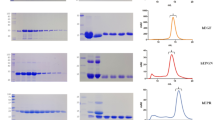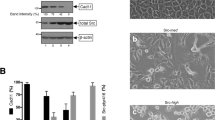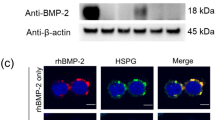Abstract
THE surface of animal cells contains a variety of complex macromolecules, some of which modulate cell growth, adhesion and motility. A number of peptide hormones and growth factors influence cellular proliferation and macromolecular synthesis with binding to surface proteins of responsive cells as the first phase of their action1–4. The structure and identity of these receptor molecules is a topic of widespread interest. Epidermal growth factor (EGF) is a low molecular weight peptide (MW 6,000) capable of stimulating DNA synthesis and proliferation in epidermal cells5, human fibroblasts6, and mouse embryo fibroblasts (3T3)7. It has also been reported to stimulate the synthesis of a major cell surface glycoprotein (CSP)8 and hyaluronic acid9 in 3T3 cells and human fibroblasts maintained in low serum. These effects occur at extremely low concentrations of EGF, in the ng ml−1 range, and the first step in this process is the specific binding to surface receptors, followed by rapid internalisation and degradation10. Pouyssegur and Pastan11 have isolated a nontransformed mutant (AD6) of BALB/c 3T3 cells that has a dramatic decrease in cell surface carbohydrates due to a specific, but partial block in the acetylation of N-acetylglucosamine-6-phosphate. This early defect in the biosynthesis of amino sugars leads to incomplete glycosylation of glycoproteins and to decreased exposure of glycoproteins on the cell surface12. Culturing the cells in the presence of N-acetylglucosamine (GlcNAc) bypasses the enzymatic block and results in a restoration of altered surface components13. We report here that the mutant AD6 cells show a dramatic decrease in EGF binding, whereas their ability to bind insulin is normal. Our data are consistent with the notion that the receptor for EGF is a glycoprotein.
This is a preview of subscription content, access via your institution
Access options
Subscribe to this journal
Receive 51 print issues and online access
$199.00 per year
only $3.90 per issue
Buy this article
- Purchase on Springer Link
- Instant access to full article PDF
Prices may be subject to local taxes which are calculated during checkout
Similar content being viewed by others

References
Pastan, I., Roth, J. & Macchia, V. Proc. natn. Acad. Sci. U.S.A. 56, 1802–1809 (1966).
Cohen, S. J. biol. Chem. 273, 1557–1562 (1962).
Hollenberg, M. D. & Cuatrecasas, P. J. biol. Chem. 250, 3845–3853 (1975).
Gospodarowicz, D. & Moran, J. S. J. Cell Biol. 66, 451–457 (1975).
Rheinwald, J. G. & Green, H. Nature 265, 421–424 (1975).
Carpenter, G. & Cohen, S. J. cell. comp. Physiol. 88, 227–238 (1976).
Rose, S. P., Pruss, R. M. & Hersham, H. R. J. cell comp. Physiol 86, 593–598 (1975).
Chen, L. B., Gudor, R. C., Sun, T. T., Chen, A. B. & Mosesson, M. W. Science 187, 776–778 (1977).
Lemback, K. J. J. cell. comp. Physiol. 89, 277–288 (1976).
Carpenter, G. & Cohen, S. J. Cell Biol. 71, 159–171 (1976).
Pouyssegur, J. & Pastan, I. Proc. natn. Acad. Sci. U.S.A. 73, 544–548 (1976).
Pouyssegur, J. & Pastan, I. J. biol. Chem. 252, 1639–1646 (1977).
Pouyssegur, J., Willingham, M. & Pastan, I. Proc. natn. Acad. Sci. U.S.A. 74, 243–247 (1977).
Todaro, G. J., DeLarco, J. E. & Cohen, S. Nature 264, 26–31 (1976).
Olden, K., Pratt, R. H. & Yamada, K. M. J. Cell Biol. 75, 68a (1977); Cell (in the press).
Pratt, R. M., Olden, K., Yamada, K. M. & Hascall, V. C. J. Cell Biol. 75, 159a (1977).
Westermark, B. Proc. natn. Acad. Sci. U.S.A. 74, 1619–1621 (1977).
Hock, R. A. & Hollenberg, M. D. Clin. Res. (in the press).
Carpenter, G. & Cohen, S. Biochem. biophys. Res. Commun. 79, 545–552(1977).
Thomopoulos, P., Roth, J., Lovelace, E. & Pastan, I. Cell 8, 417–473 (1976).
Todaro, G. J., DeLarco, J. E., Nissley, H. S. P. & Rechler, M. M. Nature 267, 526–528 (1977).
Warren, L., Buck, C. A., Tuszynski, G. P. & Fuhrer, J. P. in International Cell Biology (eds Brinkley, B. R. & Porter, K. R.) 149–158 (Rockefeller University Press, New York, 1976–1977.
Author information
Authors and Affiliations
Rights and permissions
About this article
Cite this article
PRATT, R., PASTAN, I. Decreased binding of epidermal growth factor to BALB/c 3T3 mutant cells defective in glycoprotein synthesis. Nature 272, 68–70 (1978). https://doi.org/10.1038/272068a0
Received:
Accepted:
Issue Date:
DOI: https://doi.org/10.1038/272068a0
This article is cited by
-
Recent developments in the structure, function and regulation of platelet-derived growth factor and its receptors
Cytotechnology (1989)
-
Biosynthesis and metabolic degradation of receptors for epidermal growth factor
The Journal of Membrane Biology (1986)
-
Increased phosphotyrosine content and inhibition of proliferation in EGF-treated A431 cells
Nature (1981)
-
Epidermal growth factor receptors
Molecular and Cellular Biochemistry (1981)
-
Retinoids specifically enhance the number of epidermal growth factor receptors
Nature (1980)
Comments
By submitting a comment you agree to abide by our Terms and Community Guidelines. If you find something abusive or that does not comply with our terms or guidelines please flag it as inappropriate.


